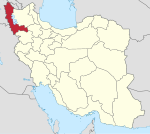Monastery of Saint Thaddeus: Difference between revisions
Undid revision 564959601 by 146.127.253.12 (talk) |
|||
| Line 13: | Line 13: | ||
}} |
}} |
||
The '''Saint Thaddeus Monastery''' ({{Lang-hy|Սուրբ Թադէոսի վանք }} - ''Sourb Tadeos Vank''; {{lang-fa|قره کلیسا}} or '' |
The '''Saint Thaddeus Monastery''' ({{Lang-hy|Սուրբ Թադէոսի վանք }} - ''Sourb Tadeos Vank''; [[Azerbaijani language|Azerbaijani]] and {{lang-fa|قره کلیسا}} or ''Ghareh Keliseh'', literally "The Black Church") is an ancient [[Armenians|Armenian]] monastery located in the mountainous area of [[Iran]]'s [[West Azerbaijan Province]], about 20 kilometers from the town of Maku.<ref>[http://armenianstudies.csufresno.edu/iaa_architecture/thaddeus.htm Index of Armenian Art: Armenian Architecture ]</ref><ref>Jude: A Pilgrimage to the Saint of Last Resort By Liz Trotta</ref> |
||
The monastery is visible from a distance because of the massiveness of the church, strongly characterized by the polygonal drums and conical roofs of its two domes. There are several chapels nearby: three on the hills east of the stream, one approximately 3km south of the monastery on the road to Bastam, and another that serves as the church for the village of Ghara-Kilise.<ref>[http://www.armenica.org/cgi-bin/history/en/getCollection.cgi?=ba=1====baz0010 Thadeus Monastery at Armenica]</ref> |
The monastery is visible from a distance because of the massiveness of the church, strongly characterized by the polygonal drums and conical roofs of its two domes. There are several chapels nearby: three on the hills east of the stream, one approximately 3km south of the monastery on the road to Bastam, and another that serves as the church for the village of Ghara-Kilise.<ref>[http://www.armenica.org/cgi-bin/history/en/getCollection.cgi?=ba=1====baz0010 Thadeus Monastery at Armenica]</ref> |
||
Revision as of 22:57, 19 July 2013
| UNESCO World Heritage Site | |
|---|---|
 | |
| Criteria | Cultural: ii, iii, vi |
| Reference | 1262 |
| Inscription | 2008 (32rd Session) |
The Saint Thaddeus Monastery (Armenian: Սուրբ Թադէոսի վանք - Sourb Tadeos Vank; Azerbaijani and Persian: قره کلیسا or Ghareh Keliseh, literally "The Black Church") is an ancient Armenian monastery located in the mountainous area of Iran's West Azerbaijan Province, about 20 kilometers from the town of Maku.[1][2]
The monastery is visible from a distance because of the massiveness of the church, strongly characterized by the polygonal drums and conical roofs of its two domes. There are several chapels nearby: three on the hills east of the stream, one approximately 3km south of the monastery on the road to Bastam, and another that serves as the church for the village of Ghara-Kilise.[3]
History and architecture
One of the 12 Apostles, St. Thaddeus, also known as Saint Jude, (not to be confused with Judas Iscariot), was martyred while spreading the Gospel. He is revered as an apostle of the Armenian Apostolic Church. Legend has it that a church dedicated to him was first built on the present site in AD 68. [citation needed]
Not much appears to remain of the original church, which was extensively rebuilt in 1329 after an earthquake damaged the structure in 1319. Nevertheless, some of the parts surrounding the altar apse date from the 10th century.
Most of the present structure dates from the early 19th century when Qajar prince Abbas Mirza helped in renovations and repairs. The 19th century additions are from carved sandstone. The earliest parts are of black and white stone, hence its Turkic name Kara Kilise, the Black Church.
A fortified wall surrounds the church and its now-abandoned monastery buildings.
In July 2008, the St. Thaddeus monastery was added to UNESCO's World Heritage List, along with two other Armenian monuments located in the same province: Saint Stepanos Monastery and the chapel of Dzordzor.
Gallery
-
Regional map showing the location of the monastery
-
A closeup view of the compound
-
Details of craftsmanship
-
Another detail view
-
View of masonry
-
Interior view

Notable details
Apostles Thaddeus and Bartholomew
According to Armenian Church tradition, the Apostles Thaddeus and Bartholomew traveled through Armenia in AD 45 to preach the word of God; many people were converted and numerous secret Christian communities were established there.
The ancient Christian historian Moses of Khorene tell the following story, considered a legend by most modern historiography.[4] Thaddeus converted King Abgar V of Edessa. After his death, the Armenian kingdom was split into two parts. His son Ananun crowned himself in Edessa, while his nephew Sanatruk ruled in Armenia. About AD 66, Ananun gave the order to kill St. Thaddeus in Edessa. The king's daughter Sandokht, who had converted to Christianity, was martyred with Thaddeus. Her tomb is said to be located near the Ghara Kelisa.
Services
It only has one service a year, on the Day of St. Thaddeus (near July first), which is attended by Armenian pilgrims from all over Iran and other countries.
References
- ^ Index of Armenian Art: Armenian Architecture
- ^ Jude: A Pilgrimage to the Saint of Last Resort By Liz Trotta
- ^ Thadeus Monastery at Armenica
- ^ David Wilmshurst (2011). The Martyred Church: A History of the Church of the East. East & West Publishing Limited. pp. 7–9. ISBN 978-1-907318-04-7. Retrieved 12 June 2012.
See also
Nearby medieval Armenian monasteries in Vaspurakan
- Saint Bartholomew Monastery, a 13th century Armenian monastery (about 110 km south-southwest in Turkey) that was built at the site of the martyrdom of Saint Bartholomew, another Armenian patron saint
- Saint Stepanos Monastery, an Armenian monastery about 82 km west in the Araks River valley
External links
- UNESCO World Heritage: Armenian Monastic Ensembles of Iran
- Thaddeus Monastery at Armeniapedia
- St Thaddeus at Armenica.org
- Armenian Architecture studies
- Hamid-Rezā Hosseini, Sound of the Ancient Bell (Avā-ye Nāghus-e Kohan - آواى ناقوس کهن), in Persian, Jadid Online, October 31, 2008, [1].
A shorter English version: Iran's World Heritage Monastery, Jadid Online, December 25, 2008: [2].
Slide show (with English subtitles): [3] (5 min 41 sec).













